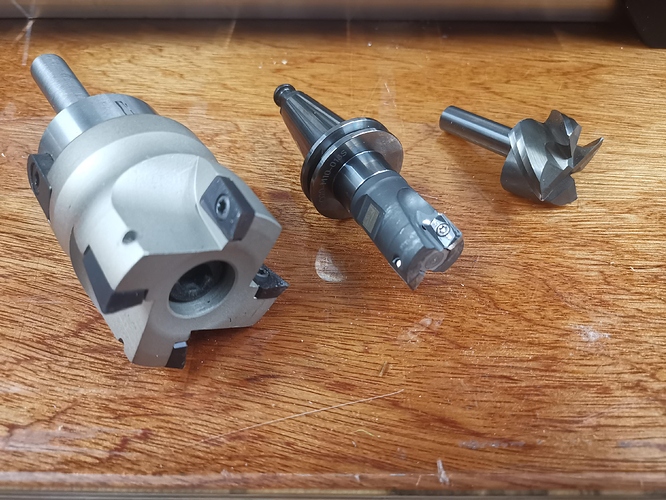This is where it gets interesting and the type of tool comes into play.
Here are three face mills I have lying around.
From right to left
- 60mm indexable face mill - turned down to fit in a spindle
- 19mm indexable face mill
- 30mm solid carbide face mill
The 60mm face mill will run in a shapeoko - but really really badly. It isn’t balance even at 100mm a min and 2000rpm a 2.2kw spindle doesn’t have the torque to make it useful. At 5000 rpm it’s max rated speed the vibrations are crazy. It is designed for a different type of machine. Yes it fits and will cut but it’s not a tool I would ever suggest anyone uses on a desktop mill
19mm indexable face mill - this is designed for HSM - it’s max rpm is 10,000 and it’s balanced, vibrations are noticeable at 12k rpm. It will chew through ali at 1mm doc 2k a min - however the atc spindle it runs on is 10kg and not suitable for a shapeoko (it also costs more than an XXL fully kitted out
30mm solid carbide face mill - this is a great bit of kit, it’s rated to 20,000 rpm, has 4 flutes and can leave a really shiny surface.
https://www.instagram.com/p/BvhUZcegxap/?utm_source=ig_web_button_share_sheet
The tool balance and max rpm make a huge difference. Personally my strategy with face mills is to hog material then a 0.2doc-0.1 finishing pass, however most of the time I will do this with a 8mm bit. Buying these large bits is ‘great’ but usually they don’t save much time unless you are running a project hundreds of times. The tool change time alone can take longer than the time saved by using one. Not to mention all tools above cost over $100. In order to get the most out of them the spindle also needs to be trammed. Note those terrible lines in the above insta pic - that’s bad tramming and on me.
